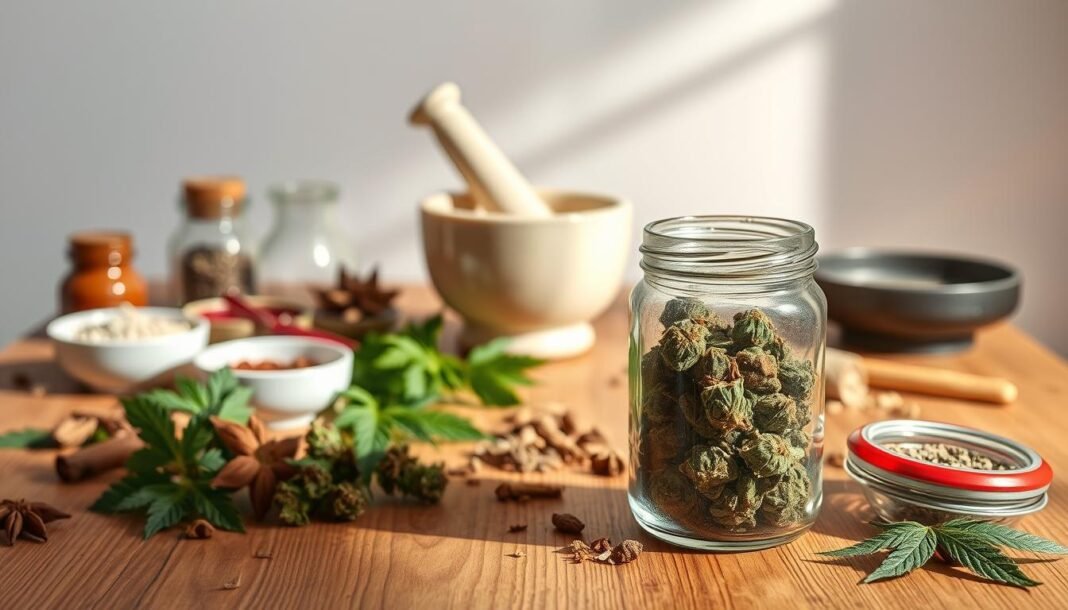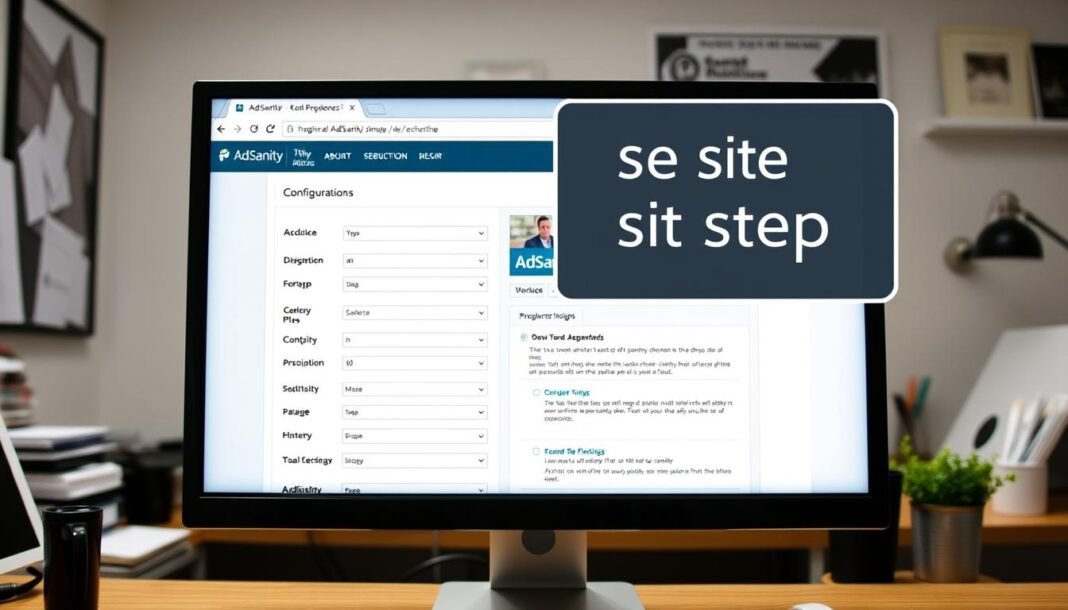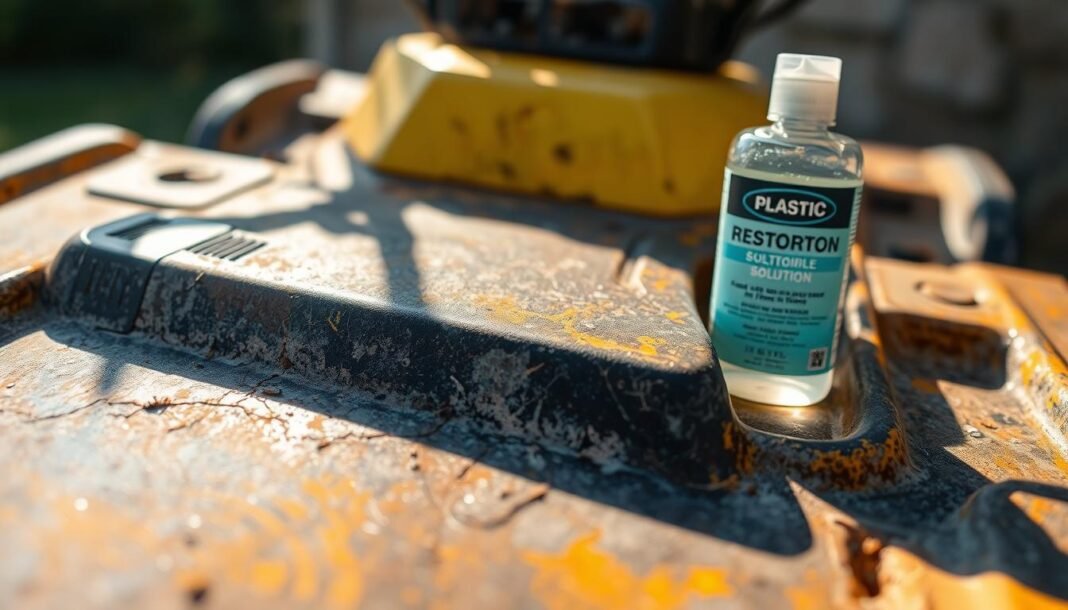Decarboxylation is key to unlocking THC and CBD in cannabis. Without an oven, you can still activate these compounds using simple methods. This guide explores practical alternatives to traditional baking, making it easy for anyone to prepare cannabis effectively.
Key Takeaways
- Decarbing converts raw cannabis into usable THC and CBD.
- No oven needed—multiple methods work at home.
- Simple tools like slow cookers or hot water can activate compounds.
- Preserve potency and control temperatures without baking.
- Perfect for beginners and experienced users alike.
Introduction to Decarboxylation
Decarboxylation is the science behind unlocking cannabis’ full potential. This process removes a carboxyl group from compounds like THCA, turning them into active THC your body can feel. Without it, raw cannabis won’t deliver the effects most users expect.
What is Decarboxylation?
At its core, decarbing transforms inactive cannabinoid acids into active compounds. Imagine baking soda becoming baking powder—this chemical shift changes how cannabis interacts with your system. Heat drives off carbon dioxide (CO₂), freeing THC or CBD for consumption. This isn’t just lab science; it’s essential for making edibles, oils, or topicals work effectively.
Why It Matters for Cannabis Use
Edibles rely on decarboxylated material to function. Without this step, THCA won’t convert to THC, leaving you with little to no psychoactive effect. Traditional ovens are common tools, but non-oven decarboxylation methods offer alternatives like slow cookers or hot water. These options provide flexibility for those without conventional equipment or prefer low-heat techniques.
Benefits of Decarbing Cannabis
Decarbing cannabis transforms raw plant material into potent, usable medicine or edibles. Proper cannabis decarbing methods ensure cannabinoids like THC and CBD become active, boosting their effects. This process turns inactive THCA into THC, making every gram count.
“Decarboxylation is the foundation of effective cannabis consumption,” say experts, highlighting how unprocessed cannabis lacks peak potential without this step.
- Higher potency in oils, edibles, and extracts
- Stronger flavor and aroma retention
- Reduced cannabis waste by activating all compounds
- Lower costs by maximizing ingredient efficiency
Non-oven cannabis decarbing methods cut energy use compared to traditional ovens. Slow cookers or sous vide setups save power while preserving terpenes. Proper decarbing also prevents over-processing, ensuring cannabinoids stay intact. Studies show optimized methods reduce cannabis waste by up to 25%, lowering per-dose costs.
Whether using water-based techniques or low-heat alternatives, mastering decarbing ensures consistent results. Every method listed here activates compounds without harsh heat, keeping your cannabis’s natural benefits intact. From saving money to enhancing effects, decarbing is essential for anyone serious about cannabis products.
How to Decarb Weed Without Oven: A Complete Guide
Decarboxylation activates compounds in cannabis, including activated THC extraction, but an oven isn’t always necessary. Explore these oven-free methods to achieve consistent results:
Overview of Non-Oven Methods
- Mason Jar Method: Use a heat gun or torch to apply precise, even heat to sealed jars.
- Microwave Technique: Short bursts at 50% power prevent overcooking while unlocking cannabinoids.
- Sous Vide: Water-bath immersion (235°F/113°C for 1-2 hours) ensures gradual activation without burning.
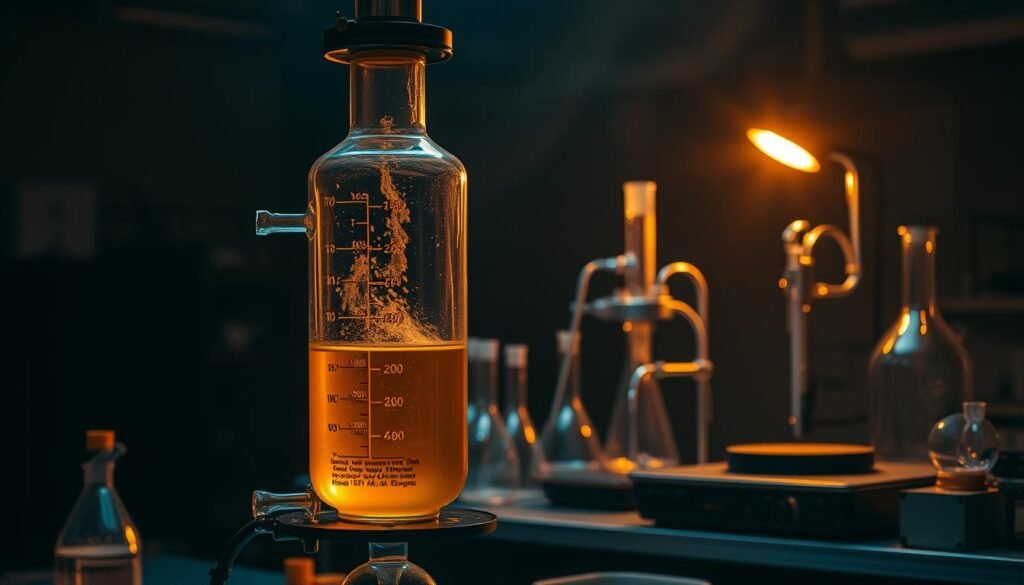
Step-by-Step Process Explained
Follow these universal steps for any method:
- Grind cannabis into uniform pieces for even heat distribution.
- Apply heat as per chosen method, maintaining ideal temps for activated THC extraction.
- Cool completely before storing in an airtight container.
Common Questions Answered
“How long does microwave decarb take?”
“8-10 minutes total, in 2-minute intervals with 1-minute rests.”
Key tips:
- Microwave method works best for small batches (1-2 ounces).
- Sous vide guarantees consistency but requires specialized equipment.
Experiment safely and adjust timing based on material quality. No matter the method, proper decarboxylation unlocks cannabis’ full potential.
Exploring Hot Water and Other Methods
Hot water baths provide a gentle approach to decarboxylation. Submerging cannabis in water heated to 190–200°F (88–93°C) activates compounds without scorching. This method preserves delicate terpenes, delivering smoother flavors for extracts.
- Hot water bath: Use a thermometer to maintain consistent temps.
- Sous vide: Sealed bags in a controlled water bath ensure precise activation.
- Slow cooker decarboxylation: Low heat for 1–2 hours with regular stirring.
Water-based methods avoid direct heat risks. Slow cooker decarboxylation uses low, steady temps, making it ideal for beginners. Stir occasionally to prevent uneven heating. For sous vide, seal cannabis in a food-safe bag and submerge in a preheated water bath. All methods require patience—activation takes time but ensures quality.
Test small batches first. Adjust timing based on material texture. Glass containers are safer than plastic for water baths. Always monitor temperatures to prevent over-decarbing, which can degrade cannabinoid profiles.
Using a Slow Cooker for Decarboxylation
Slow cookers provide a hands-off approach to decarboxylation, ideal for preserving cannabis potency. Compared to hot water decarboxylation, this method uses steady low heat to activate compounds without direct flame. The key is balancing temperature and time to avoid overcooking.
Temperature Guidelines
Set your slow cooker to low heat (200–212°F). Avoid exceeding 240°F to prevent burning. Use a thermometer for accuracy. Preheating ensures even distribution.
Timing Considerations
Decarb time depends on heat settings. Follow this guide:
| Setting | Time | Notes |
|---|---|---|
| Low | 2–3 hours | Preserves delicate terpenes |
| Medium | 1.5–2 hours | Balance between speed and quality |
| High | 1 hour | Risk of losing flavor potency |
Tips for Best Results
- Use a glass insert to avoid residue buildup
- Stir every 30 minutes for even heat
- Spread cannabis evenly across the bottom
- Cover loosely to allow vapor escape
Always let cannabis cool before use. Unlike hot water decarboxylation, this method requires minimal monitoring once set up. Experiment with small batches to refine your process.
Efficient Techniques for Activated THC Extraction
Once cannabis is decarbed, the next step is extracting activated THC for use in decarbed edibles. This process ensures maximum potency and flavor in homemade products like brownies or oils. Let’s break down the science and methods.
Understanding THC Activation
Decarboxylation removes carboxyl groups from THCA, turning it into psychoactive THC. This chemical shift happens at around 240°F (115°C) over 30–45 minutes. Without this step, raw cannabis won’t deliver the expected effects in decarbed edibles.
Methods of Extraction
Choose a method based on your goals:
- Oil Infusion: Simmer decarbed cannabis in neutral oil (coconut or olive oil) for 1–2 hours. Strain and use for baking or dressings.
- Butter Infusion: Combine decarbed flower with water and butter. Simmer, strain, and store. Perfect for decarbed edibles like cookies or sauces.
- Alcohol Extraction: Use high-proof alcohol to dissolve THC. Evaporate the alcohol to avoid harsh flavors, leaving a potent concentrate.
| Method | Pros | Cons |
|---|---|---|
| Oil Infusion | Easy, retains flavor | Longer cooking time |
| Butter Infusion | Classic for decarbed edibles | Fat-soluble, may require straining |
| Alcohol Extraction | Fast, high yield | Requires alcohol evaporation |
Always strain extracts to remove plant material. Store in a cool, dark place for best results. Experiment to find your favorite method for crafting quality decarbed edibles.
Precautions and Safety Tips in Decarbing
Mastering safe decarboxylation starts with understanding risks and best practices. safety tips for decarbing are key to avoiding accidents and preserving cannabis quality. Follow these steps to protect yourself and your materials:
- Use a thermometer to track temperatures. Keep heat between 230–250°F to avoid burning without an oven.
- Work in a well-ventilated area. Open windows or use fans to reduce strong odors and fumes during the process.
- Wear heat-resistant gloves and use glass or ceramic tools. Avoid plastic, which can melt or release toxins at high temps.
- Never leave decarbing materials unattended. Overheating can ignite flammable materials or ruin your cannabis.
- Clean equipment thoroughly after use. Residual oils or residue may cause future contamination or fires.
Properly stored cannabis should be kept in airtight containers after decarbing. Always prioritize ventilation and heat control to minimize risks. These steps ensure safe, effective results every time.
Comparing Oven and Non-Oven Methods
Choosing between traditional ovens or alternative methods depends on your priorities. This section breaks down how each approach stacks up across key factors.
Accuracy and Consistency
Ovens provide precise temperature control, ensuring even decarboxylation. But they require constant monitoring to avoid burning. Slow cookers or sous vide systems offer reliable results with minimal supervision, though they may vary slightly in timing.
Energy Efficiency
Energy efficiency decarboxylation shines with non-oven methods. Ovens demand high heat for hours, increasing energy costs. In contrast, methods like water baths or crock pots use less power, making them eco-friendly and cost-effective. For example, a slow cooker uses ⅓ the energy of an oven for the same task.
Preserving Potency
Non-oven techniques often retain more natural flavors and terpenes. Lower-temperature methods protect delicate compounds, preserving the plant’s original aroma and effects. Ovens, when overheated, can degrade cannabinoids, reducing potency over time.
Creative Recipes and Uses Post-Decarb
Decarbed cannabis opens doors to endless cannabis-infused recipes and inventive uses. Whether baking, blending drinks, or crafting skincare, these ideas let you enjoy cannabis in safe, flavorful ways. Start by storing decarbed material in airtight jars before creating your favorites.
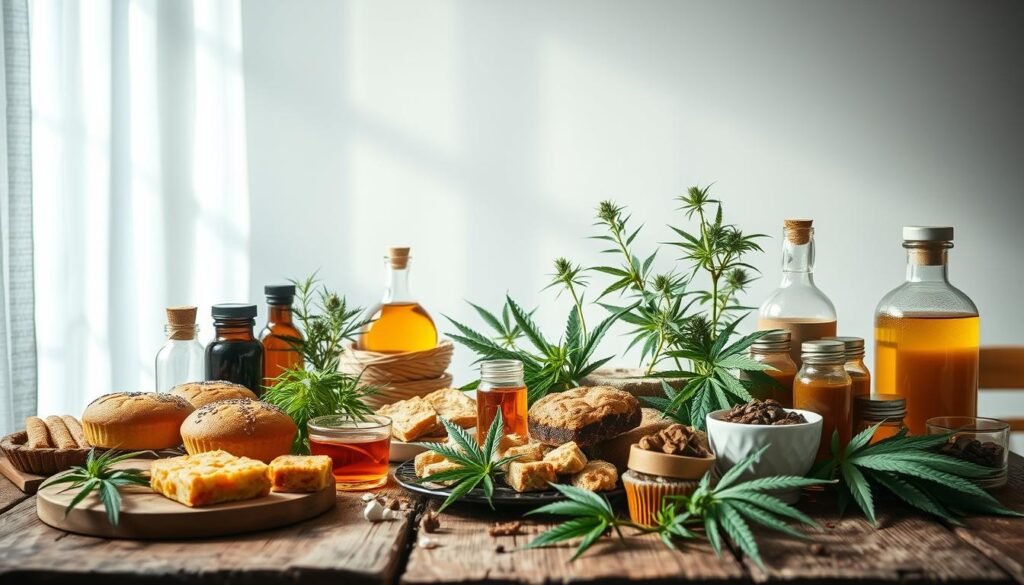
Edibles Preparation
Begin with classic edibles. Cannabis-infused butter or oil forms the base. Mix 1 oz decarbed flower with coconut oil, heat gently for 2-3 hours, then strain. Use this in cookies, brownies, or pasta sauces. Pro tip: Start with ¼ oz flower per batch for mild effects.
Cannabis-Infused Beverages
- Teas: Steep decarbed flower in hot water for 10 minutes. Add honey or lemon.
- Smoothies: Blend decarbed material into fruit smoothies. Use 1-2 tsp per serving.
- Hot chocolate: Mix infused butter with cocoa powder and milk for cozy sips.
Topicals and More
Create lotions or balms by mixing decarbed cannabis with shea butter. Apply to skin for localized relief. DIY balms can include essential oils like lavender for extra relaxation. Store in cool, dark places for up to 6 months.
Experiment safely! Always test small batches first. Adjust dosages based on personal tolerance. Share your cannabis-infused recipes with friends to explore new culinary and wellness possibilities.
Conclusion
This cannabis decarboxylation guide highlights practical ways to activate cannabis compounds without an oven. Methods like slow cookers or hot water efficiently transform raw plant material, making THC available for edibles or topicals. By following precise steps from this guide, users unlock maximum potency without specialized equipment.
Safety and consistency are central to successful decarbing. The guide stresses avoiding high heat to preserve cannabinoids, ensuring each technique balances effectiveness and ease. Non-oven methods match traditional oven approaches in quality while saving energy and space, as shown in method comparisons.
Experiment with the techniques outlined here to create infused recipes or lotions. Proper decarboxylation ensures every batch retains its therapeutic and recreational benefits. This guide simplifies the process, making it accessible for beginners and experienced users alike. Prioritize caution, and enjoy exploring cannabis’ potential through these proven oven-free strategies.


